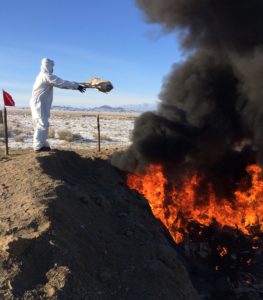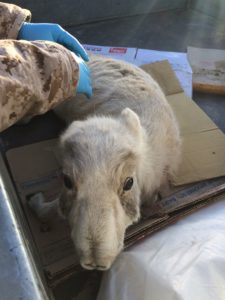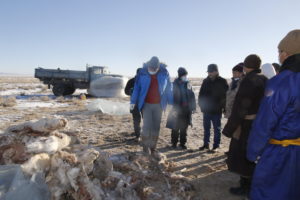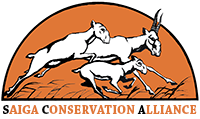HELP US SAVE MONGOLIA’S UNIQUE WILDLIFE
 An outbreak of a devastating disease, peste-des-petits ruminants (sheep and goat plague) is killing saiga antelopes and other unique and imperiled animals in Mongolia.
An outbreak of a devastating disease, peste-des-petits ruminants (sheep and goat plague) is killing saiga antelopes and other unique and imperiled animals in Mongolia.
Already more than 2,500 saigas have suffered a horrible death, and the epidemic only seems to be picking up speed.
Experts from the Saiga Conservation Alliance‘s in-country partners – WWF Mongolia and WCS- Mongolia – and scientists from the Mongolian Academy of Sciences, Royal Veterinary College and FAO, are on the scene, investigating the causes and working with government agencies trying to stop the spread of the disease before more of saigas and other animals fall victim to it.
What we know so far
 In 2016, sheep and goat plague was recorded in domestic animals from two provinces in western Mongolia: Khovd and Gobi-Altai. The government took swift action, vaccinating over 14,000,000 livestock in the area against this disease. Tragically this has not stopped the spread of this lethal plague to vulnerable wild animals such as saigas, Ibex, Goitered Gazelle and Mongolian Gazelle. This will inevitably have knock-on effects to predators such as snow leopards which are also found in this region, as they will find it harder to find food.
In 2016, sheep and goat plague was recorded in domestic animals from two provinces in western Mongolia: Khovd and Gobi-Altai. The government took swift action, vaccinating over 14,000,000 livestock in the area against this disease. Tragically this has not stopped the spread of this lethal plague to vulnerable wild animals such as saigas, Ibex, Goitered Gazelle and Mongolian Gazelle. This will inevitably have knock-on effects to predators such as snow leopards which are also found in this region, as they will find it harder to find food.
Experts are advising that the outbreak is likely to continue until fresh grass comes through and animals can disperse, which will not be before late April in this part of Mongolia.
The Mongolian saiga is a unique subspecies of saiga, whose total population is found in one area of Mongolia and whose numbers were estimated at just 10,000 in 2016. As this population differs genetically from the populations found in Kazakhstan, Russia and Uzbekistan this means that the current disease outbreak has already claimed more than 10% of this subspecies, and if deaths continue unabated, the Mongolian Saiga will be in grave danger of losing as much as 80% of its population.
Chimeddorj Buyanaa, Conservation Director of WWF Mongolia noted: “The local government agencies are working in line with Mongolian legislation which requires all the bodies to be disinfected. For this purpose, in total seven burial sites have been planned. So far four of them have been filled with the infected carcasses of over 2,500 saigas and goitered gazelles. However, we estimate that over 3,000 saiga might already be dead.”
What is being done to help?
 Currently teams of scientists, NGOs and agencies are working together to advise the Mongolian government on a strategy to contain the disease. Updates will be issued as key decisions are reached, and these will be publicised, amongst other places, on the Saiga Conservation Alliance website and through its social media channels.
Currently teams of scientists, NGOs and agencies are working together to advise the Mongolian government on a strategy to contain the disease. Updates will be issued as key decisions are reached, and these will be publicised, amongst other places, on the Saiga Conservation Alliance website and through its social media channels.
The good news is that there is a vaccine for sheep and goat plague, which means that if we can help now at Mongolia’s time of need, in the longer term the disease can be controlled.
Fundraising appeal
We are launching an appeal to support efforts on the ground to save not only saigas, but the other wildlife which are affected:
Funds are urgently needed to:
- Support on-going research by veterinarians, scientists, NGOs and government agencies into the outbreak, previous vaccination programme and possible solutions to halt it.
- Monitor saigas and other wildlife populations in the area, namely goitered gazelle, ibex, argali, Mongolian gazelle, wild boar and even wild camels, to check for disease so that managers can target their vaccinations and protection in the right places.
- Support education and awareness amongst local people so they understand the risks of this devastating disease and how to protect both their livestock and saigas from infection by avoiding pasturing their flocks near saiga herds or disturbing saigas.
- Fund extra anti-poaching patrols, so that the saiga’s depleted population is not further affected by opportunistic poaching.
Together we can help Mongolia’s conservationists to support their unique and precious wildlife through this terrible time.
PLEASE VISIT OUR FUNDRAISING PAGE HERE, AND CONSIDER SUPPORTING MONGOLIA’S UNIQUE WILDLIFE
THANK-YOU
More news, images and video clips here from the WCS newsroom
